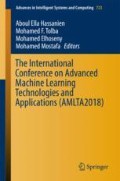Abstract
Cross-site scripting (XSS) is one of the most frequently occurring types of attacks on web applications, hence is of importance in information security. XSS is where the attacker injects malicious code, typically JavaScript, into the web application in order to be executed in the user’s browser. Identifying that a script is malicious is an important part of the defence of a web application. This paper investigates using SVM, k-NN and Random Forests to detect and limit these attacks, whether known or unknown, by building classifiers for JavaScript code. It demonstrated that using an interesting feature set combining language syntax and behavioural features results in classifiers that give high accuracy and precision on large real world data sets without restricting attention only to obfuscation.
Access this chapter
Tax calculation will be finalised at checkout
Purchases are for personal use only
References
Examples of malicious javascript (2014). https://aw-snap.info/articles/js-examples.php. Accessed 16 Dec 2016
Aebersold, S., Kryszczuk, K., Paganoni, S., Tellenbach, B., Trowbridge, T.: Detecting obfuscated JavaScripts using machine learning. In: International Conference on Internet Monitoring and Protection. IARIA Press (2016)
Balzarotti, D., Cova, M., Felmetsger, V., Vigna, G.: Multi-module vulnerability analysis of web-based applications. In: Computer and Communications Security, pp. 25–35. ACM Press (2007)
Domingos, P.: A few useful things to know about machine learning. Commun. ACM 55(10), 78–87 (2012)
Fernandez, K., Pagkalos, D.: XSS (Cross-Site Scripting) information and vulnerable websites archive. XSSed.com. Accessed 14 June 2017
Karnad, K.: XSS payloads you may need as a pen-tester (2014). https://www.linkedin.com/pulse/20140812222156-79939846-xss-vectors-you-may-need-as-a-pen-tester. Accessed 25 Dec 2016
Kirda, E., Jovanovic, N., Kruegel, C., Vigna, G.: Client-side cross-site scripting protection. Comput. Secur. 28(7), 592–604 (2009)
Kirda, E., Kruegel, C., Vigna, G., Jovanovic, N.: Noxes: a client-side solution for mitigating cross-site scripting attacks. In: Symposium on Applied Computing, pp. 330–337. ACM Press (2006)
Komiya, R., Paik, I., Hisada, M.: Classification of malicious web code by machine learning. In: Awareness Science & Technology (iCAST), pp. 406–411. IEEE (2011)
Likarish, P., Jung, E., Jo, I.: Obfuscated malicious JavaScript detection using classification techniques. In: Malicious and Unwanted Software (MALWARE), pp. 47–54. IEEE (2009)
Malviya, V.K., Saurav, S., Gupta, A.: On security issues in web applications through cross site scripting (XSS). In: Asia-Pacific Software Engineering Conference, vol. 1, pp. 583–588. IEEE (2013)
Nadji, Y., Saxena, P., Song, D.: Document structure integrity: a robust basis for cross-site scripting defense. In: Network and Distributed System Security Symposium. Internet Society (2009)
Nunan, A.E., Souto, E., dos Santos, E.M., Feitosa, E.: Automatic classification of cross-site scripting in web pages using document-based and url-based features. In: Computers and Communications, pp. 702–707. IEEE (2012)
OWASP Top 10 - 2017 rc1 (2017). https://www.owasp.org. Accessed 7 June 2017
XSS Payloads: XSS payloads you may need as a pen-tester. http://www.xss-payloads.com/payloads.html. Accessed 14 Oct 2016
Pietraszek, T., Berghe, C.V.: Defending against injection attacks through context-sensitive string evaluation. In: Recent Advances in Intrusion Detection, Lecture Notes in Computer Science, vol. 3858, pp. 124–145. Springer (2005)
Raman, P.: JaSPIn: JavaScript based anomaly detection of cross-site scripting attacks. Ph.D. thesis, Carleton University, Ottawa (2008)
Rocha, T.S., Souto, E.: ETSSDetector: a tool to automatically detect cross-site scripting vulnerabilities. In: Network Computing and Applications, pp. 306–309. IEEE (2014)
Su, Z., Wassermann, G.: The essence of command injection attacks in web applications. ACM SIGPLAN Not. 41(1), 372–382 (2006)
Van Gundy, M., Chen, H.: Noncespaces: using randomization to defeat cross-site scripting attacks. Comput. Secur. 31(4), 612–628 (2012)
Vogt, P., Nentwich, F., Jovanovic, N., Kirda, E., Kruegel, C., Vigna, G.: Cross site scripting prevention with dynamic data tainting and static analysis. In: Network and Distributed System Security Symposium, p. 12. Internet Society (2007)
Wang, W.H., Yin-Jun, L.V., Chen, H.B., Fang, Z.L.: A static malicious javascript detection using SVM. In: International Conference on Computer Science and Electronics Engineering, vol. 40, pp. 21–30. Atlantis Press (2013)
Weinberger, J., Saxena, P., Akhawe, D., Finifter, M., Shin, R., Song, D.: A systematic analysis of XSS sanitization in web application frameworks. In: European Symposium on Research in Computer Security. Lecture Notes in Computer Science, vol. 6879, pp. 150–171. Springer (2011)
Williams, J., Manico, J., Mattatall, N.: Cross-site Scripting (XSS). https://www.owasp.org/index.php/Cross-site_Scripting_(XSS). Accessed 22 July 2016
Xu, W., Zhang, F., Zhu, S.: JStill: mostly static detection of obfuscated malicious JavaScript code. In: Data and Application Security and Privacy, pp. 117–128. ACM Press (2013)
Author information
Authors and Affiliations
Corresponding authors
Editor information
Editors and Affiliations
Rights and permissions
Copyright information
© 2018 Springer International Publishing AG
About this paper
Cite this paper
Mereani, F.A., Howe, J.M. (2018). Detecting Cross-Site Scripting Attacks Using Machine Learning. In: Hassanien, A., Tolba, M., Elhoseny, M., Mostafa, M. (eds) The International Conference on Advanced Machine Learning Technologies and Applications (AMLTA2018). AMLTA 2018. Advances in Intelligent Systems and Computing, vol 723. Springer, Cham. https://doi.org/10.1007/978-3-319-74690-6_20
Download citation
DOI: https://doi.org/10.1007/978-3-319-74690-6_20
Published:
Publisher Name: Springer, Cham
Print ISBN: 978-3-319-74689-0
Online ISBN: 978-3-319-74690-6
eBook Packages: EngineeringEngineering (R0)

